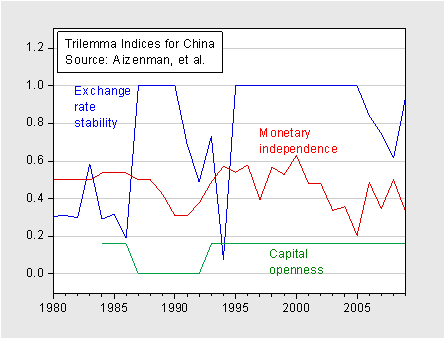The Aizenman, Chinn and Ito indices that measure how countries align their policies to conform to the Trilemma [1] [2] [3] have been updated to 2009. Below is a time series plot of exchange rate stability, monetary independence and capital account openness for China.

Figure 1: exchange rate stability (blue), monetary independence (red), and capital openness (green). Source: Aizenman, Chinn and Ito.
The monetary independence index depends on the correlation of a country’s interest rates with the base country’s interest rate, the exchange rate stability index is measured by the exchange rate volatility, and the degree of financial integration is measured with the Chinn-Ito capital controls index.
The data (Excel, Stata), as well as associated documentation are here. All you wanted to know about the capital openness index, here.
Pegging the exchange rates, provides for less flexibility with the domestic monetary policies.It may be assumed that China is now departing from former rigidities on monetary policies and EXR.
Bresil,Russia,India may follow through as econgrapher charts show.
http://econgraphergraphs.blogspot.com/search/label/Country%20-%20China
How about the capital openness change,once EXR,monetary policy have gained independence and the trilemma obliges?
Menzie,
A couple of questions.
What country is the base country in the monetary independence index?
What is the exchange rate volatility measured against? Volatility is relative to what?
Menzie,
Those were serious questions.
Can we assume the base country is the US?
Is the volatility measured against itself, or against the dollar, or against a basket of currencies, or an index, or something else?
Ricardo: I don’t check comments consistently. In any case, all these questions are in the documentation (in any of the papers that are linked to), or have been described in the earlier posts on the Trilemma indices. Base country is not necessarily the US; it depends what country is being pegged to (see Jay Shambaugh’s work).
Volatility is standard deviation of the first log difference of monthly exchange rate data, where the exchange rate is defined against the base country.
Menzie,
Sorry, I didn’t intend to be pushing. I was afraid you thought that my questions were rhetorical rather than serious.
I’m sorry but you still didn’t answer my first question. All you have to do is tell me which country is your base country for your graph. I understand the concept. I assumed it was the US but I wasn’t sure. Is that correct?
Again your answer to the second question is cryptic. I assume that you are saying that the volatility of the RMB is measured against the dollar. Is that correct?
Ricardo: Oh, I see. For China, base country is US.